Poseidon’s Fury: Escape from the Lost City
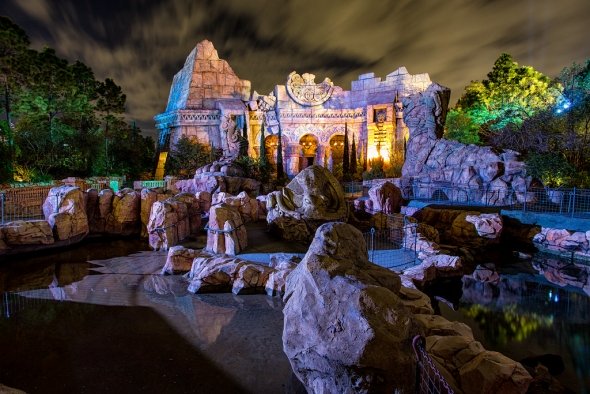
Standing before the crumbled remains of the Temple of Poseidon in 1999, you would have to agree that if this towering facade does one thing very well, it’s setting expectations high. The monumental exterior alone is enough to draw guests in… even if they’re not entirely sure what it is they’re queuing for.
The mystery of Poseidon’s Fury: Escape from the Lost City is made all the more intriguing by the team stationed at the temple’s entrance, dressed in hooded cloaks and floating around the area like wraiths… Something mythical is certainly at work inside… But what?

Thankfully, the winding, stone queue that descends into the temple’s heart at least provides a hint… Just as guests dutifully line the dark corridors headed deep into the ruins, so too do painted worshippers carrying offerings of crops. We’re walking in their footsteps, headed to an altar somewhere deep in the dark, cool, wet passages.
But there’s a subtler insinuation here, too… As guests proceed further into the temple, the frescoes become old and worn, with layers crumbled away by time and the elements. The exposed, older paintings beneath reveal the worshippers as merpeople bearing tributes of the sea. It seems that at one time, this temple was in honor of the great god Poseidon, and that something happened to change that…
At long last, you’re admitted to the Mural Chamber – a dark room lit only by flickering lanters. Luckily, our guide emerges from a hovel on the wall, scurrying down a ladder. The old, hunched-over man with a curling white beard introduces himself as the Keeper – for he holds the tales of this ancient temple…
And in particular, of an ancient battle long ago, where the beloved king of the gods, Zeus, was challenged for dominance by his brother, Poseidon, who threatened to flood the world to show his superiority. As the Keeper’s tale unfolds, inexplicable lighting and sounds sweep across the room, illuminating ancient murals on the vaulted ceiling – one of the righteous Zeus, lightning bolt reared back, and – opposite – the serpentine, green-skinned Poseidon… the same figure whose head we saw outside.
But as the Keeper tells of Poseidon’s vow to return and overthrow Zeus with an army of the seas, the inexplicable lighting cast across the room disappates and an ethereal, female voice stirs. “You are quite a storyteller old man…”
“What? Who said that!”
“Who I am matters not… What matters is who you are.“
“Oh, er, um, yes, call me ‘The Keeper!’ For I am–”
“Not you,” the voice interrupts before quizzically adding, “Them…”
Sensing there may be more than appears to the group of tourists before her, the disembodied voice next invites us into a second chamber, built around a massive stone doorway – its concentric circular locks misaligned and sealed. Above it is a large gem in the center of an octopode carving. Our entrance into the temple has awakened the spirit who resides in the gem… The Oracle, Gatekeeper to Atlantis – a rear-projected face viewed through the crystal. The Oracle and the Keeper momentarily spar (with more than a few references to Greek poems and old time spats difficult for most guests to keep up with).
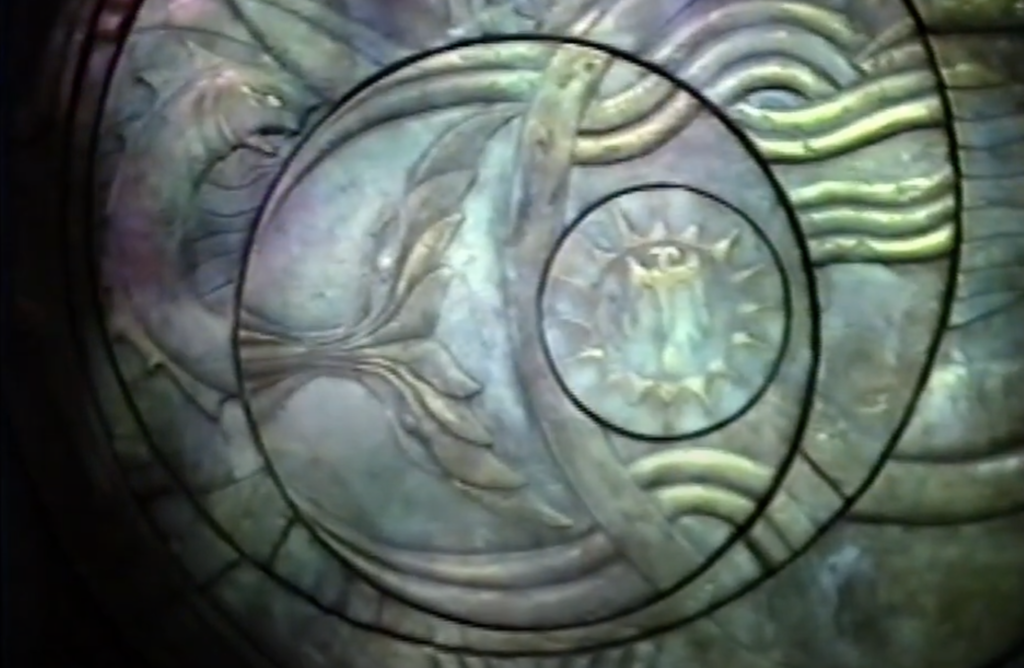
But hopefully, the gist is clear: It turns out that the Oracle isn’t exactly on Zeus’s side… “For those worthy of Poseidon, a gateway to a world of wonders beyond measure awaits…” She offers the Keeper (and us) an audience with Poseidon in his home deep in Atlantis where he’s been imprisoned since the battle. And there’s just one way to get there. “Concentrate on the symbol!” she shouts, as projections illuminate the misaligned circular locks.
As the shimmering Oracle begins to recite a spell, the interlocking circles of the portal begin to twist and realign. As if by magic, light emanates from the cartuche as its twisting, grinding gears align throughout reveal the embedded shape of a fish, transforming into a siren, crashing waves, an octopus, and more…
“Sea of serpents, oceans wide, abate your dark and drowning tide;
Allow safe passage through the waves that may these mortals few yet brave;
Discover ‘neath the ocean’s floor, Atlantis where none have gone before;
Let that which has too long been sealed open again and be revealed;
Unite the world of sea and land for Poseidon’s greatness to command;
For with each twist and every turn, the moment nears of his return
When ancient score shall be avenged, as Lord Poseidon rules again…”
As the final tumblers lock into place, the portal reveals its hidden image: the face of Poseidon (though, quite obviously, not the same character design used in the rest of the show).
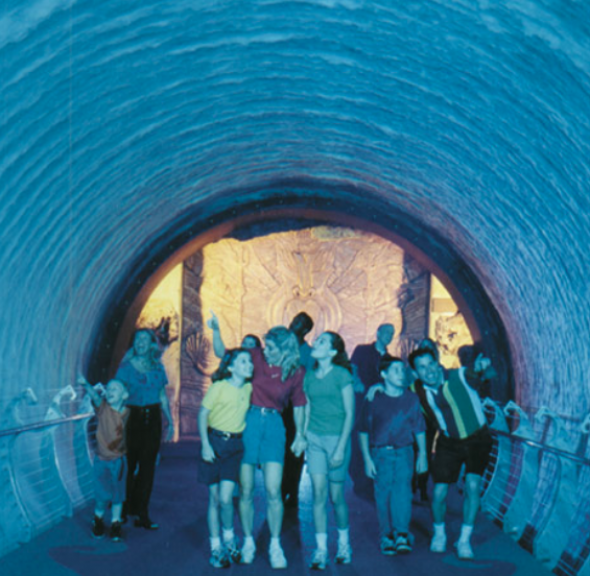
The Oracle instructs, “Once the Vortex to Atlantis has formed, make haste quickly through, for it cannot remain for long.” The massive stone door rumbles to life, rolling aside as steam escapes from within. Then, a torrential wave of water washes across the path ahead, growing in strength until it overcomes the bridge through the tunnel, “sticking” to the walls and forming the portal to Atlantis.
Once inside, guests find themselves in the massive, cavernous Chamber of Poseidon, with a multi-stepped pool of water ahead and large “windows” into the ocean all around (temporarily displaying “bubble” screenscavers until all guests have safely taken their places). Once all guests have entered, the show begins as the Keeper steps out into the rocky pools, climbing higher in the temple. Then, through the “windows,” Poseidon appears – an animated character voiced by the unimitable Jeremy Irons (legendary actor and iconic voice behind The Lion King’s Scar).
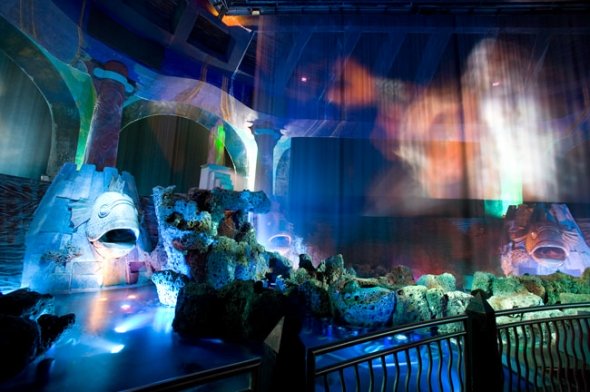
When the Keeper announces he’s come to clear things up about Zeus, Poseidon flies into a rage. “You dare not mention that name!” He cries, slapping water that erupts in the temple. Suddenly, “rain screens” fall all around guests, seemingly transporting Poseidon into the room, projected just in front of guests. Then – in one of the most memorable sights – Poseidon was projected all around guests in dozens of incarnations, as if projected through a crystal or kaleidoscope. He speaks directly to the gathered crowd: “Soon, you will join my army, and we will rise up and crush Zeus once and for all.”
“I cannot allow that to happen!” The Keeper cries, now standing upright.
“Really? And just what do you intend to do about it?” Poseidon mocks.
“This!” At once, the Keeper disappears, replaced by an animated Zeus on screen. A full-on special effects battle follows, with Zeus harnassing fire against Poseidon’s water in the cavernous temple just in front of guests. 25-foot fireballs blast, singeing skin with heat quelled only by Poseidon’s retaliatory bursts of steam and mist.
Unsurprisingly, Zeus triumphs… but on-screen, Atlantis begins to collapse from the battle! Zeus’s booming voice cries:
“Ancient titans of Heaven and Earth,
Restore these mortals to the land of their birth.
For mercy’s sake I call on thee,
Deliver them from beneath the sea.
Lest not we tend an ocean grave,
I call upon their lives to save!”
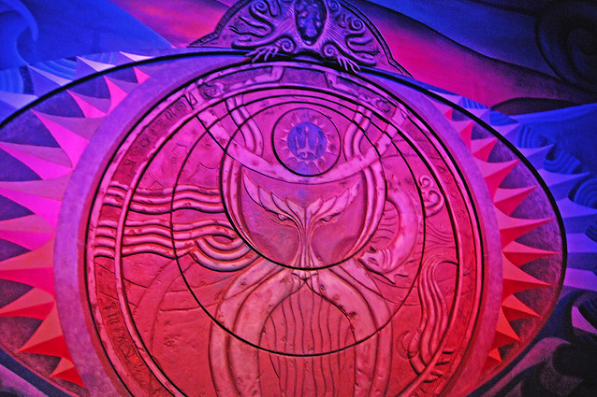
As steam, then darkness overcomes the chamber, the lights return to show… that we’re back in the Oracle’s Chamber! Initially, merely Zeus’s disembodied voice would indicate that we’d survived, but this finale didn’t test well, leaving guests confused about if the attraction was over, unsure of what to do next, and not noticing or appreciating that they’d “traveled back” to a previous room. For a while, the Keeper would reappear, his latern breaking the darkness as he’d show the returned vortex portal and say, “Well, that looks familiar!” – a winking nod to the “teleportation” effect allowing the Keeper to then escort guests out.
Though the “original” Poseidon’s Fury is practically a legend, mostly unrecorded, a single video of the experience exists – and it’s unexpectedly clear, too! However, this walkthrough does omit chunks of the experience, getting across just the key moments. Be sure to check it out:
Poseidon’s Fury was impressive in scale… but it was not the headlining attraction Universal had promised… Don’t worry; we’ll explain why.
Problems, problems, problems
Late in the attraction’s development, the fate of Poseidon’s Fury had been handed to Universal Show Producer Amelia Gordon. Amelia’s job was to manage the creative development needed to get Poseidon’s Fury over the finish line in time for the park’s opening… and on a strict budget, to boot. Obviously, there are incredibly compelling elements of the Poseidon’s Fury show that Amelia and her team inherited.
As evidence, it continued to be a marketing highlight of the new park and an oft-cited example of its astounding technological breakthroughs:
But polling by Universal allegedly revealed that Poseidon’s Fury wasn’t performing as they’d hoped.
From a guest point-of-view, visitors seemed to report that the attraction was confusing and muddled; it was hard to understand and hampered by both poor lighting and unclear sound, with only torches and “magical” light effects able to illuminate necessary paintings and carvings; that it felt like the first room was nothing but overcomplicated exposition; its second room, a muddled mess led by the “humorous” sparring of the Oracle and Keeper without much clarity about what was happening or why; that its conclusion, too, was difficult to follow. As celebrated as the final “teleportation” effect was, it seemed that few guests even registered that the illusion was meant to make them feel they’d moved “back” a room.
In short, audiences seemed to leave Poseidon’s Fury shellshocked. “…Is it over?” It didn’t feel like an experience to match the impressive exterior, much less its supposed role as an anchor attraction of the new park. From a story-writer and experience designer’s point-of-view, it had a few equally-glaring errors.
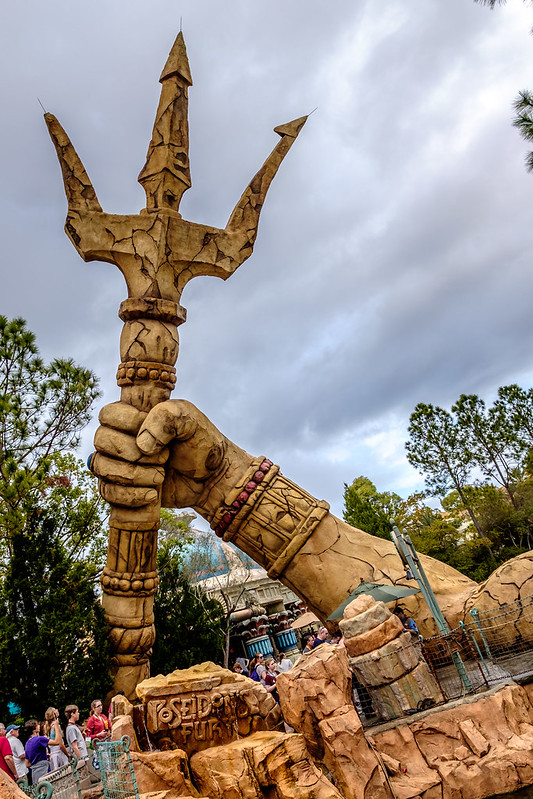
- AN UNSYMPATHETIC HOST – While some retrospectively think of him as an enigmatic and beloved “Dreamfinder” type, our “old” guide, the Keeper – always played (by necessity) by a 20-something Universal Team Member in a bad nylon wig and robe – felt disconnected from the audience; literally, more of a “storyteller” than a “hero.” He seemed to exist above the action, not in it; he neither connected with guests nor grounded their experience. He was, quite literally, a character.
- AWKWARD LOAD-IN MOMENTS – The “necessary evil” of a guided, room-by-room walking tour is that guests need to safely load into each chamber – typically 60-90 seconds of “dead” time – before lighting can be lowered, doors can be closed, and the show can begin. The already-disconnected Keeper character had the unenviable job of vamping to keep guests occupied. But moreover, that loading lag time was especially noticeable when exiting the Vortex and stepping into Atlantis. Under load-in lighting, fountains, exit signs, industrial walls, light rigs, and HVAC systems that will make the show possible were all painfully obvious, while “bubble screen” screensavers instantly reveal the water screens ahead. In other words, long before the show could even begin, many of the secrets of Atlantis were already on display… literally.
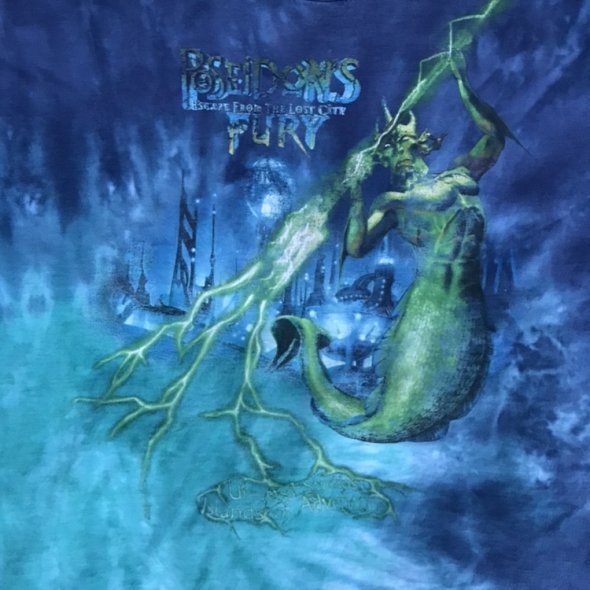
- THE MYTHOLOGY AND PACING – While no one would expect a 15 minute theme park special effects extravaganza to win an Academy Award for its screenplay, the overly-complex set-up of Poseidon’s Fury failed to make much sense to guests. Quick rewrites during the show’s first year attempted to make the Keeper more personable and entire rerecordings of the Oracle changed the second chamber’s tone (and the Vortex’s spell) to reiterate each character’s allegiance, emphasize the portal’s role and importance, fill the portal’s long alignment, and literally explain to guests that it was leading to Atlantis.
- ABSENT “MAIN” CHARACTERS – Even still, one of the attraction’s most fatal flaws was simply that two of its three rooms were spent merely hearing about the hero and villain; we didn’t knowingly hear from either until the third and final room…! And more to the point, when we finally encountered the main characters two-thirds of the way into a fifteen minute show, both materialized as late-90s CGI cartoon characters… Not exactly in line with the realism set up by the attraction’s first ten minutes, and perfectly exemplifying the next issue…
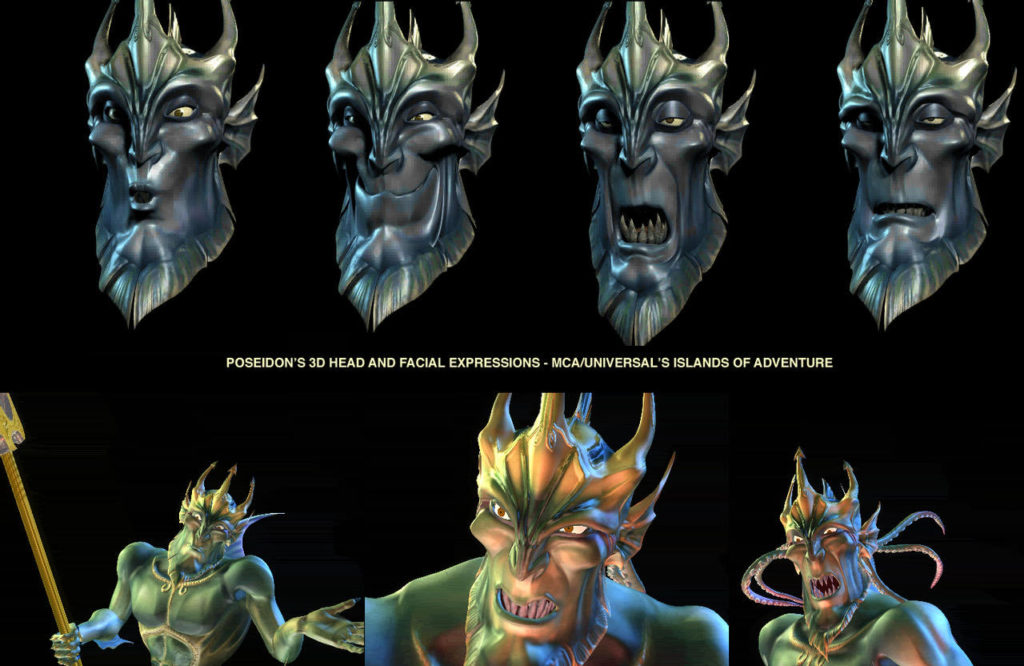
- THE LACK OF DANGER – Though many words are said about Poseidon throughout the Keeper’s exposition, it seems that the character we finally meet in the finale (voiced superbly by Jeremy Irons, voice of Scar in The Lion King) is merely cranky, not dangerous; a reveal made all the worse by his being a cartoon merman and his presumably animated army. Poseidon comes across as more of a brooding Disney villain who might break into song at any moment than as a real threat, which feels disconnected with the otherwise self-serious attraction.
- MISSING MOTIVATION – This is perhaps the most damning complaint against the show from a story-writer’s point of view. Why are we here? Why did we queue in this temple to begin with? Do we have a “role” in the story? Is it 1999, or two thousand years ago? Why is the Keeper leading us into what he knows to be a trap? Do we even need to be here for this battle to take place? Or did Zeus simply carry us room-to-room because he wanted an audience to passively watch him, our own safety be damned?
Think you’ve got it figured out? What would you do? Something needed to change, and to reverse the sinking of their multi-million dollar technological marvel, Universal had to call in the big guns. On the next page, we’ll show you exactly what designers had to work with and how they set out to salvage Poseidon’s Fury.




I definitely agree with some of your points and not so much with others. Saying someone is “alleged [blank]” can ruin their life. But if they are exonerated, there’s never a headline about that. As the writer you absolutely have the choice to mention it. Regardless, thank you for your thoughtful response and I do not wish for this to distract from the great journalistic work here.
You mention that “in fairness” you should mention assault allegations against the creator. But it seems that “in fairness” allegations wouldn’t be mentioned at all.
I wouldn’t typically approve – much less respond – to a comment so far afield of the attraction or memories associated with it, but in this case, I figured I should.
I suppose it depends on whom you intend to be fair to. Yes, allegations are just allegations. But as a writer and storyteller, it’s important to me that we acknowledge those claims for several reasons.
For one, here at Park Lore, we believe people when they report being victims of sexual assault or abuse. Believing victims does not mean that alleged crimes shouldn’t be investigated or that the alleged perpetrator is guilty. With that said, it would be unfair to those who reported this alleged abuse – and indeed, any reader who’s been assaulted or abused – to simply “not mention” it. I guess I’m “woke” like that.
Second – and as an extreme example – Bill Cosby legally has no convictions for his alleged crimes; Jeffrey Epstein is unconvicted in his 2019 case; OJ Simpson wasn’t convicted in 1994. But of course, just “not mentioning” that “in fairness” to any one of them would be an outrageous oversight and journalistic omission in any sort of discussion of that entertainer’s life, work, and legacy. It’s not even “political” or taking a “position” on a hot button issue; it’s part of telling the complete story.
Finally, as a storyteller who generally prides himself on contextualizing the “bigger picture” of the industry and the creators who work on these attractions, it’s important to me that we’re able to intellectually and emotionally differentiate the works of art we love from the often flawed humans who bring it to life. As a tremendously pivotal figure in many attractions that have shaped me, I can’t not talk about Gary Goddard and his impact on the industry I love. But any story here that celebrates his ideas shouldn’t read like a deification or veneration of him as a person. Contextualizing the role of Goddard and his contributions requires acknowledging allegations that – “fair” or “unfair” – are a part of his story.
You (hopefully) came here for “in-depth, interconnected, and inclusive” theme park storytelling. That’s what I promised, and this is how I do it.